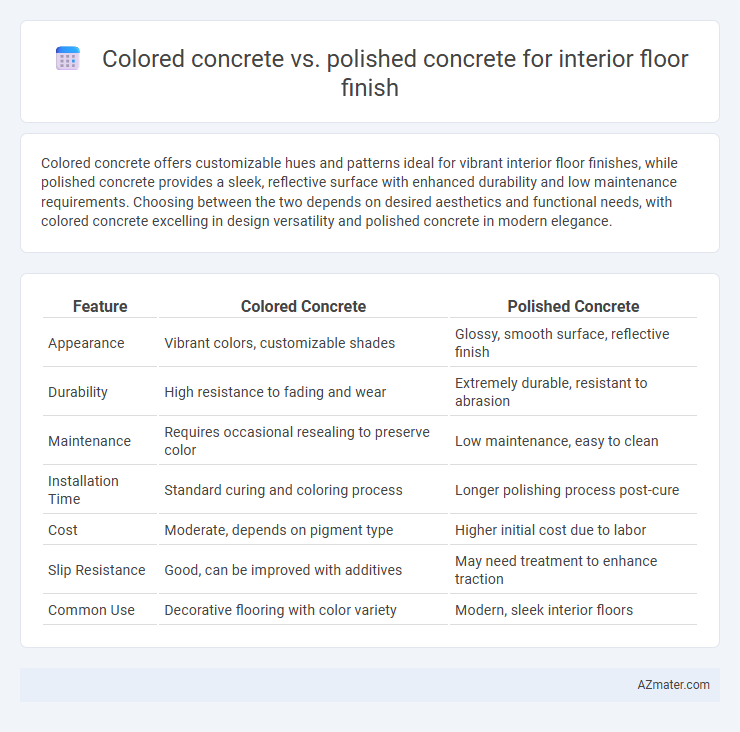Colored concrete offers customizable hues and patterns ideal for vibrant interior floor finishes, while polished concrete provides a sleek, reflective surface with enhanced durability and low maintenance requirements. Choosing between the two depends on desired aesthetics and functional needs, with colored concrete excelling in design versatility and polished concrete in modern elegance.
Table of Comparison
| Feature | Colored Concrete | Polished Concrete |
|---|---|---|
| Appearance | Vibrant colors, customizable shades | Glossy, smooth surface, reflective finish |
| Durability | High resistance to fading and wear | Extremely durable, resistant to abrasion |
| Maintenance | Requires occasional resealing to preserve color | Low maintenance, easy to clean |
| Installation Time | Standard curing and coloring process | Longer polishing process post-cure |
| Cost | Moderate, depends on pigment type | Higher initial cost due to labor |
| Slip Resistance | Good, can be improved with additives | May need treatment to enhance traction |
| Common Use | Decorative flooring with color variety | Modern, sleek interior floors |
Introduction to Colored and Polished Concrete
Colored concrete enhances interior floor finishes by integrating pigments directly into the concrete mix, offering customizable hues and design versatility while maintaining durability. Polished concrete involves mechanically grinding and polishing the surface to achieve a smooth, glossy finish that reflects light and improves floor hardness without additional coatings. Both methods provide unique aesthetic and functional benefits suitable for residential, commercial, and industrial interiors.
Key Differences: Colored vs Polished Concrete
Colored concrete incorporates pigments to achieve a wide range of hues and patterns, offering versatile aesthetic options for interior floors. Polished concrete features a mechanically ground and finished surface that enhances durability and produces a high-gloss, reflective shine without adding color. The key difference lies in colored concrete's emphasis on customized color and design, while polished concrete prioritizes surface smoothness and longevity with a natural gray or neutral finish.
Aesthetic Appeal and Design Options
Colored concrete offers a versatile palette and customizable pigment blends that create vibrant, uniform tones or intricate patterns, enhancing interior floor aesthetics with bold, artistic expression. Polished concrete emphasizes a sleek, reflective surface that showcases the natural aggregate for a sophisticated, modern look, with variable gloss levels from matte to high shine. Both finishes allow design flexibility, but colored concrete excels in color variety while polished concrete maximizes texture and light interaction for subtle elegance.
Durability and Longevity Comparison
Colored concrete offers excellent durability with pigments integrated into the mix, ensuring long-lasting color that resists fading, chipping, and wear in high-traffic interior spaces. Polished concrete enhances surface hardness through a multi-step grinding and sealing process, providing superior resistance to abrasion, stains, and moisture penetration for extended longevity. Both finishes maintain structural integrity over time, but polished concrete typically delivers a more robust, low-maintenance floor ideal for heavy-use environments.
Maintenance Requirements and Costs
Colored concrete requires periodic sealing and occasional cleaning to prevent staining and maintain its vibrant hues, with moderate maintenance costs typically lower than those of stained or tiled floors. Polished concrete demands less frequent maintenance, mainly routine cleaning to retain its glossy finish, which reduces long-term upkeep expenses despite potentially higher initial polishing costs. Both options offer durable interior flooring solutions, but polished concrete generally provides a more cost-effective and low-maintenance choice over time compared to colored concrete.
Application and Installation Process
Colored concrete offers vibrant, customizable hues ideal for decorative interior floors, requiring pigment mixing during batching and precise surface finishing to enhance color uniformity. Polished concrete involves grinding and polishing the slab with progressively finer abrasives, creating a smooth, reflective surface that emphasizes durability and low maintenance. Both applications demand professional expertise, but colored concrete installation centers on pigment integration and curing, while polished concrete focuses on mechanical abrasion and sealing techniques.
Environmental Impact and Sustainability
Colored concrete often incorporates pigments and additives that may contain synthetic materials, potentially affecting its environmental footprint, whereas polished concrete relies primarily on mechanical grinding and sealing with minimal chemical use, enhancing its sustainability. Polished concrete typically has a longer lifespan due to its durability and low maintenance requirements, reducing the need for replacement and resource consumption over time. Both options offer eco-friendly flooring solutions, but polished concrete is generally favored for lower embodied energy and reduced waste production during installation and use.
Cost Analysis: Colored vs Polished Concrete
Colored concrete typically incurs higher initial costs due to the price of pigments and additives required to achieve vibrant, customizable hues. Polished concrete, while often less expensive upfront, involves ongoing maintenance expenses to preserve its glossy finish and resist wear. Evaluating long-term costs highlights colored concrete's potential for sustained aesthetic appeal with lower upkeep compared to the periodic grinding and sealing needed for polished concrete floors.
Best Use Cases for Each Finish
Colored concrete is ideal for decorative interior floors in retail spaces, restaurants, and residential areas where vibrant hues and custom patterns enhance aesthetic appeal and brand identity. Polished concrete suits high-traffic commercial environments like warehouses, offices, and showrooms, offering a sleek, durable surface with low maintenance and increased resistance to wear and stains. Both finishes provide unique durability, but colored concrete emphasizes visual impact, while polished concrete prioritizes functionality and longevity.
Choosing the Right Concrete Finish for Your Interior Floors
Choosing the right concrete finish for your interior floors depends on design goals and maintenance needs. Colored concrete offers vibrant, customizable hues ideal for artistic and bold designs, while polished concrete provides a sleek, reflective surface with enhanced durability and easy upkeep. Both finishes improve the longevity of floors, but polished concrete typically requires less frequent resealing and is more resistant to stains and wear.

Infographic: Colored concrete vs Polished concrete for Interior floor finish
 azmater.com
azmater.com